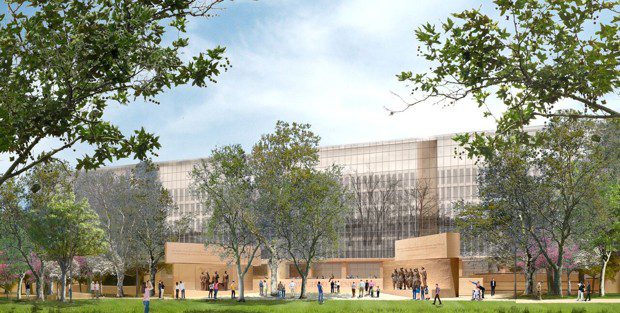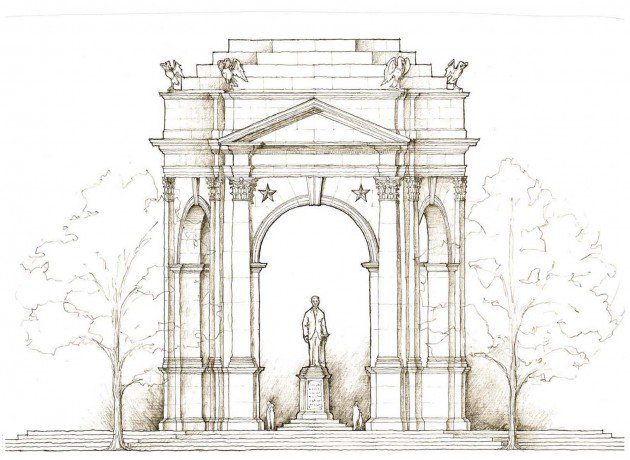Will Eisenhower Ever Have a Fitting Memorial?

Few seem to really like it, but for now it seems to be limping along to somewhere. That sentiment describes the latest chapter in the saga of the Dwight D. Eisenhower Memorial. It was commissioned by Congress in 1999, and eventually given a site on a public square in Washington a few blocks from the Capitol. But almost two decades later, the project has yet to even break ground—or even finalize a design.
In February, the National Capital Planning Commission (NCPC) allowed three proposed changes to the Eisenhower Memorial design, giving the oft-stalled project permission to proceed a step toward an uncertain future. The 16-year-old memorial project is carried forward not so much by momentum as it is by resignation.
The Eisenhower family, the commissioners, and the general public all appear resigned to an increasingly muddled and expensive collection of elements piled and hung beneath the stern gaze of the Department of Education building. Some still fight to do “Right by Ike,” advocating scrapping starchitect Frank Gehry’s design entirely for a less-deconstructed memorial design found through open competition, and more appropriate to the classicism of the great presidential monuments. But even these traditionalists find previous incarnations preferable to the latest design alterations. They hope that reluctance may turn into opposition—and eventually the chance may come to go back to the drawing board.
“It’s not like one of these classic memorial controversies where there are two actual sides competing,” said Justin Shubow, president of the National Civic Art Society (NCAS). “Here it’s everybody against the Eisenhower Memorial Commission.”
But even members of the Dwight D. Eisenhower Memorial Commission find the current design proposal objectionable. Bruce Cole, a former chairman of the National Endowment for the Humanities appointed to the Eisenhower commission in 2013 by President Obama, commented in an email to TAC:
It’s hard to believe, but the new design makes the Eisenhower Memorial even more incomprehensible. The boy Ike has almost disappeared from sight, leaving the Memorial without a focal point and a free standing statue of the president. The enormous metal screen now features a sort of photographic scene of present day Omaha beach. How this empty image tells the story of the heroism and sacrifice that occurred there is unclear.

Cole’s objection summarizes the changes to the memorial proposal. Under the Gehry design as approved in July 2015, the memorial consists of three statues and an 80- by 447-foot steel mesh tapestry suspended from pillars (with a few more elements thrown in), all set in an embowered four-acre site boxed in by Independence Avenue, Fourth and Sixth Streets SW, and the U.S. Department of Education building, a site approved in 2006. The statues depict President Eisenhower as a young man, as a general, and as commander-in-chief. The original design sought to set up a narrative of Ike’s journey from midwestern boyhood to global greatness, placing him as a young man before the tapestry, which then was to depict a composite of Ike’s Abilene, Kansas, while gesturing to the future. No longer.
Now, boy Ike is to be set behind the screen, facing its rear, atop a wall of quotes with his back to the DoE building. And the tapestry is to depict a “contemporary peacetime image” of Normandy, France, focusing on Omaha and Utah Beaches with Pointe du Hoc at the center. Approximately four planned trees will not be planted in the new design. In a February meeting, many NCPC members expressed concern about the altered memorial’s coherence, readability, and even whether the landscape on the tapestry would be identifiable. They approved the changes on the grounds that they were primarily aesthetic ones, not altering the fundamental memorial plan, and outside their purview.
Others disagree. At the NCPC meeting and subsequent interview, Shubow said the movement of the young Eisenhower and the change of tapestry subject represents “a radically changed concept for the memorial” and removes the narrative element of Gehry’s original, what Shubow considers the best part of a bad concept. “What we’ve ended up with is a classic example of design by committee,” Shubow said.
How? And what’s next?
The commission to give President Eisenhower a memorial was written into existence in 1999, with the first official meeting of its commissioners assembling in early 2001. Rather than holding an open design contest, they rapidly settled on Frank Gehry, reportedly a longtime associate of commission Chairman Rocco Siciliano. With site and design guidelines finalized in 2006, already far too late for the originally planned 2007 completion, the proposed groundbreaking moved to 2012.
But in 2011, Shubow’s National Civic Art Society published a report criticizing the design and process, arguing it was inappropriate and too expensive. Unable to get funding and approvals, and despite the report and criticisms from the Eisenhower family, veterans, and many others, the commission continued to put together preliminary site and building plans through 2014. While the proposed design received approval from the NCPC and the U.S. Commission of Fine Arts in 2015, it failed to gain the approval of the Eisenhower family, without which the EMC could not (and still cannot) secure sufficient financial support.
Former Secretary of State James Baker III, who serves on the memorial advisory board, led negotiations with the Eisenhowers. In 2012, Eisenhower’s son, John S.D. Eisenhower wrote, “Taxpayers and donors alike will be better served with an Eisenhower Square that is a green open space with a simple statue in the middle, and quotations from his most important sayings,” But in 2016, Ike’s granddaughter Susan wrote that “While some of us may have had other preferences in the past, all of us support your proposal,” meaning the modified design. Now the commission will put together mock-ups and presentations for the Commission on Fine Arts, who unlike the NCPC will have no reason to hesitate in rejecting the design on aesthetic grounds.
When asked about the timeframe for giving their approval, CFA secretary Thomas Luebke described the process as a little bit like the judiciary, with the CFA waiting for the Eisenhower commission to approach them: “In terms of timing and the process, the ball is really in their court.”
The commission will also seek to secure funding, and a waiver from Congress allowing them to begin building prior to the project being fully funded. In an email, commission spokesperson Chris Kelley Cimko of Cimko Strategies said:
The commission’s budget request will be submitted to Congress in the near future and is currently not public. We’ve had a great first quarter of fundraising thanks to the hard work of our Finance Chairman, Senator Bob Dole and EMC Chairman, Pat Roberts. The Eisenhower grandchildren have joined the EMC Advisory Committee and are actively engaged in commission activities.
Past budgets have been almost $150 million, which Shubow said is more than the cost of the Lincoln Memorial, Jefferson Memorial, and Washington Monument combined.

Meanwhile critics, including NCAS and the “Right By Ike” movement, hope that the CFA will kill the proposed amendments—or the commission will fail to secure sufficient funding. Either setback could be enough to restart the process.
Referencing a congressional study of the memorial’s cost increases, delays, and design failures, “A Five-Star Folly,” Right by Ike’s Sam Roche said:
The design for the Eisenhower Memorial remains controversial because the commission in charge circumvented the usual public process for the memorial’s design. A Congressional report found the process was full of irregularities and led to big overruns in cost, compensation, and schedule. Right by Ike has advocated for a return to the standard public process to design and complete Ike’s memorial, through a competition open to everyone.
Shubow thinks a changed political climate might help too, explaining that the National Civic Art Society is “optimistic that Congress and the new president will recognize just how bad the design is and just how much a waste of money it is.”
“In our opinion it’s better to get it right than to rush it. Veterans don’t want a bad memorial.”
Micah Meadowcroft, a former editorial assistant at The American Conservative, is a writer based in Washington.
This article was supported by a grant from the Richard H. Driehaus Foundation.
Comments